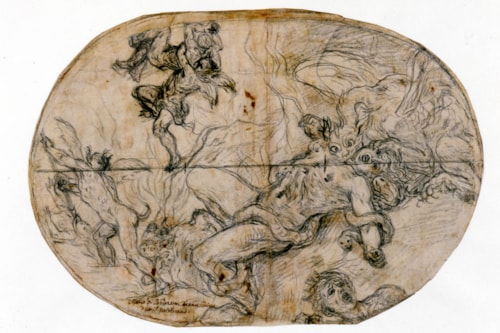
Baldassare Franceschini VOLTERRANO
Volterra 1611 - Florence 1690
Biography
The preeminent fresco painter in Florence in the latter half of the 17th century, Baldassare Franceschini, known as Il Volterrano after his birthplace, studied with Matteo Rosselli and Giovanni da San Giovanni. His first significant independent commission came in 1636, when he was entrusted by Prince Don Lorenzo de’ Medici with the fresco decoration of the courtyard of the Medici villa of La Petraia, near Florence. This cycle of scenes from Medici history was not completed for another twelve years, however, as other commissions interrupted the project.
Volterrano painted frescoes, altarpieces and easel pictures for numerous churches and palaces in Florence, Volterra and Rome. His large-scale, crowded fresco compositions reflect an adaptation into a Florentine idiom of the Roman Baroque manner, derived from Pietro da Cortona’s frescoes in the Palazzo Pitti, where Volterrano himself also worked, decorating the ceiling of the Sala di Vittoria della Rovere. His painting style also shows the influence of Correggio, whose work in Parma he studied extensively; indeed one of Volterrano’s biographers, Niccolò Gabburri, describes the artist as ‘il secondo Correggio o pure il Coreggio dei Fiorentini.’
In 1650 Volterrano painted a large fresco of The Angels Ministering to Christ in the Wilderness for the refectory of the Florentine convent of Santa Teresa, a work he considered to be one of his finest achievements. Some of the artist’s most significant commissions were for Santissima Annunziata in Florence, where his fresco decoration of the chapel of Sant’Ansano in 1643 began an association with the church that was to last almost to the end of his career. Between 1664 and 1683, Volterrano executed paintings for the ceiling of the nave of the church and an altarpiece of San Filippo Benizzi in Glory, and his work at Santissima Annunziata culminated in the cupola fresco of The Coronation of the Virgin. Commissioned by the Grand Duke Cosimo III, the fresco was the artist’s last major project, as he suffered a stroke shortly after its completion.
Undoubtedly one of the finest draughtsmen of the Florentine Seicento, Volterrano, as one modern scholar has noted, ‘can take his place alongside the other major draughtsmen of the Baroque era; there is nothing provincial about any aspect of his drawing.’ Both of the artist’s biographers, Filippo Baldinucci and Francesco Maria Niccolò Gabburri, owned several of his drawings, and they were also popular with collectors. The largest extant groups of drawings by Volterrano are today in the collections of the Uffizi and the Albertina, while a number of designs for architecture, decorative motifs and metalwork are in the Kunstbibliothek in Berlin.



